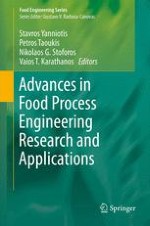Abstract
Food process design is concerned with the engineering design and economics of industrial food processes. Quantitative analysis of food processing operations requires material and energy (heat) balances on the process flowsheet. Equipment and energy (heat) requirements are calculated from rate equations of momentum (flow), heat, and mass transfer.
Process engineering calculations require the thermal and transport properties of foods, which are taken from the literature. Reliable values of thermal properties (specific heat and enthalpy changes) can be predicted from empirical correlations or taken from published data.
Transport properties (viscosity, thermal conductivity, and mass diffusivity) are strongly affected by the composition and physical structure of the food product, such as apparent density and porosity.
The rheological properties of fluid foods are affected by the size and concentration of the dissolved molecules or suspended particles. Temperature has a stronger effect on the viscosity of concentrated solutions, such as sugars, than on the apparent viscosity of suspensions.
Experimental data on thermal and mass diffusivity are essential. The thermal conductivity of solids decreases at higher porosities, while the opposite effect is observed with mass diffusivity. Temperature has a small effect on thermal conductivity, while mass diffusivity is affected strongly in nonporous and less in porous solids.
Heat and mass transfer coefficients in food process design are affected by the heat transfer medium, food material, and process equipment. Approximate values of the transfer coefficients are obtained from data in the literature and empirical correlations.
